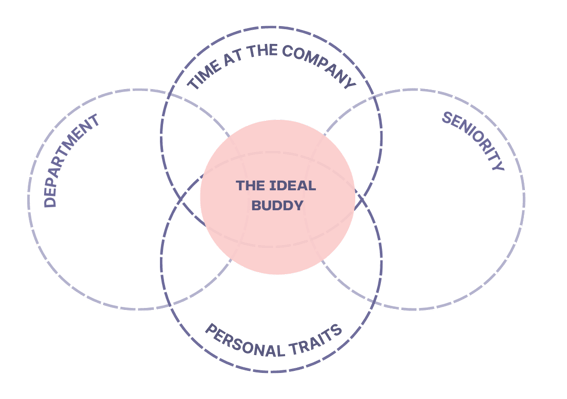An onboarding buddy is a guiding light to new hires as they navigate the unchartered territory of a new job. Without a buddy system, new hires are at risk of feeling lost and isolated, while organizations risk decreased time to productivity, low retention rates, and increased hiring costs.
To get the most out of an onboarding buddy system, you’ll want to ensure you understand what a buddy program is at work, why an onboarding buddy is important, how to choose the right mentors and the practical aspects of setting up an amazing buddy system in the office and remote. Ready to get started?
What is an onboarding buddy?
An onboarding buddy or onboarding mentor is an existing employee who is paired up with a new hire to help guide them through their first few weeks. This will include providing information on day-to-day life at work, answering any questions that might arise as they get settled, and being the social link to the wider team.
An onboarding buddy provides a human touch to the practicalities of employee onboarding, and helps new hires get started on the right foot from day one.
Why is an onboarding buddy important?
New employees can feel out of their comfort zone when first starting a job. Finding the way around a new office, communicating with unfamiliar colleagues, and navigating different procedures can be a stressful process. And this is before new hires even begin adjusting to their workload.
Employees with a ‘work best friend’ are 60% more likely to want to go to work than those without. Laying the foundations for these personal connections within the onboarding process will fast-track new hires from nervous newbies to comfortable colleagues in no time.
What are the benefits of an onboarding buddy system at work?
An onboarding buddy system benefits new hires, existing employees, and organizations.
For new hires, onboarding buddies act as a valuable resource for contextual information about your workplace, are an easy ‘in’ to existing social circles, and offer a wealth of knowledge that new hires may otherwise struggle to come by. Having these aspects of starting in a new environment covered, new hires can do what they want to do – get on with their job.
73% of new hires are more productive at work with the help of a buddy system. So not only will your buddy program ensure new hires feel capable in their new role, your organization will improve key HR metrics.
An onboarding buddy system also offers professional benefits to the employees choosing to mentor new hires.
Choosing a good onboarding buddy
Deciding which employee would excel as a buddy is an important and somewhat difficult decision. Depending on the size of your organization you’ll want to consider these 4 key criteria:

→ Time at the company
How long has your buddy been at the company? Are they fairly fresh and brimming with enthusiasm or do they have the wealth of wisdom that comes from knowing an organization for many years?
→ Department
Does your buddy work in the same department as your new hire? Or, do they offer an opportunity for cross-department collaboration? A buddy within the same department as your new hire is a surefire way to get them settled into their immediate team as quickly as possible. Alternatively, a cross-department pairing offers the unique benefits of interacting with different teams throughout the business.
→ Seniority
A general safe rule of thumb is to pair your new hire with someone at a similar level to them. Buddies working at a lower level than your new hire may not provide them with the depth of knowledge they might need. On the other hand, pairing with significantly more senior employees could prevent new hires from asking questions and lead to them losing out on the benefits of a buddy system completely. An exception to this rule, however, would be if there was an opportunity to bridge a knowledge gap by partnering a new hire with a more experienced employee.
→ Personal traits
An onboarding buddy will represent your organization so it’s important to make sure they understand and uphold the mission and values of your business. Alongside that, buddies should be great communicators, well-integrated socially within the team, and have the willingness to help new employees get started.
And while this helps in selecting the right people for your buddy system, it just as much comes down to good training for your mentors-to-be.
How do you set up an onboarding buddy system?
Setting up a successful buddy system is a three-step process, starting with some groundwork, running the program and improving it for even better results in the future.

1: Build your framework (the what and why)
Before you get started, you’ll want to make sure you have clear goals and expectations for your buddy journey, and that these are understood by your HR team and relevant stakeholders.
→ Set your goals
A well-built buddy system can help support key HR metrics. First, review your recent metrics. Then, see where there is room for improvement. Does your organization need to focus on increasing productivity, or would teams benefit from efforts to boost engagement, belonging, and ambassadorship? Setting clear goals gives your buddy system direction and something to benchmark its success.
→ Align stakeholder expectations
Key stakeholders in a buddy system will include the employee buddy, the direct team of the new hire, and the managers of both involved. Setting expectations for all parties is key to a successful buddy system. Make sure to touch on the responsibilities of a buddy, when and how long a buddy will be occupied with buddy duties, and what aspects the new hires’ manager thinks would be important to cover in the first weeks.
→ Incentivize your buddy
One of the biggest factors to consider when setting up a buddy system is how you will incentivize the program. Will buddies volunteer or will you assign them to the task? As the program will add additional work to an existing workload, it’s important to communicate the value of being involved, whether that’s professional development, leadership potential, or a tangible incentive like a gift card.
2: Put it into practice (the how)
Once the why and how are covered, it’s time to consider how you’ll put your plans into practice.
→ Prep your buddy
Being a buddy should be an enjoyable experience. Part of this is ensuring there are clear guidelines in place to avoid any unexpected responsibilities. The other part is allowing buddies the freedom to add their own flare to a program. Giving buddies the autonomy and means to add their personal touch will ensure your buddy stays engaged and your new hire has a personalized experience.
→ Plan a buddy timeline
Build an effective timeline to make sure your new hire has support at key moments during the first weeks. You’ll want to cover this in-depth, but here are a few starting points:
The starting points:
| Before they start: |
Plan to meet up with your new hire up to 3 times before the first day. |
| First day: |
Greet your new hire in the morning. Plan a midday catch-up and a check-in after work. |
| First week: |
Introduce the new hire to the team over the first week. Check-in daily for a quick chat. |
| Extend beyond: |
Schedule weekly 30 min check-ins for the duration of the program to continue the support needed. |
→ Use software for success
Keeping tabs on the progress of every new hire’s buddy program used to be a time-consuming and nearly impossible task for HR. Now, thanks to onboarding software you can set up notifications, deliver relevant documents, and manage catch-ups all from the convenience of an app.
Keeping your buddy on track and your new hire informed has never been easier. Want to know how the onboarding buddy system is performing overall? Check-in with new hires with a quick feedback form to get their thoughts on their onboarding experience.
3. Measure and improve (looking forward)
So you’ve made your framework and put it into practice? Now it’s time to streamline and strengthen your program. You’ll want to check in with your new hires, buddies, and their managers to make sure everyone’s needs and expectations are being met.
Your list of things to check will vary depending on your organization and the teams involved. But here are 4 key questions for each stakeholder you can start with:
→ Are your new hires receiving the support they need?
- How do they rate their buddy’s performance, communication, and availability?
- Do they feel they have had the opportunity to meet their colleagues?
- What improvements would they recommend?
→ Does your buddy feel well prepared to perform as a mentor?
- Did they feel understood the goals, expectations, and responsibilities of the program?
- Do they feel their workload has been adjusted to allow room for buddy responsibilities?
- What improvements would they recommend?
→ Is your new hire’s manager satisfied with the progress their new team member is making?
- How helpful do they feel the buddy program has been to settling their new hire into the team?
- Do they feel that the new hire has received the information originally planned?
- What improvements would they recommend?
→ Does your buddy’s manager feel satisfied that their team member is managing the additional responsibilities on top of their existing workload?
- How much is the buddy system interfering with their employees workload?
- Does their need to be adjustments made to the schedule?
- What improvement would they recommend?
This feedback can be sourced manually, however, if you’re managing a large scale buddy program you’ll benefit from the ease of automation with Talmundo software. Set up scheduled feedback surveys for every stakeholder involved and receive notifications when improvements are needed. This way you’ll be able to make adjustments to individual programs as well as make improvements to your organization’s broader buddy system.
Onboarding buddies for remote workers
There are 44% more employees working remotely now than there were 5 years ago. This changing landscape means employers need to adapt their onboarding processes.
So how do you make sure your growing number of remote new hires don’t fall through the cracks? Use your most valuable assets – your onboarding buddies and onboarding software.
An onboarding buddy for remote employees is arguably even more important than for those working from the office. Combined with the technological safety net of onboarding software, you can prevent remote workers from being forgotten. Regular online buddy check-ins, digital onboarding content, and online social events can help replace feelings of isolation with a sense of belonging.
 |
The takeaway
|
Implementing an onboarding buddy system is the foolproof way to set your new hire up for success. By pairing new employees with existing team members you can ensure they receive the guidance and support they need to thrive in their new environment. In the meantime, you’ll help your organization improve employee engagement, increase retention, and promote a positive company culture.
Setting up an onboarding buddy for the eventual new hire is simple, but doing it at scale throughout different countries and offices requires a different approach. To maximize the effectiveness of your onboarding buddy program, it’s crucial to carefully select the right employee for the role based on the needs of your new hire and size of your organization. Additionally, setting clear goals and expectations, incentivizing participation, and utilizing onboarding software can help enhance the success of the program for both in-office and remote employees.







